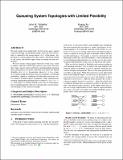| dc.contributor.author | Tsitsiklis, John N. | |
| dc.contributor.author | Xu, Kuang | |
| dc.date.accessioned | 2014-10-20T13:09:43Z | |
| dc.date.available | 2014-10-20T13:09:43Z | |
| dc.date.issued | 2013-06 | |
| dc.identifier.issn | 01635999 | |
| dc.identifier.uri | http://hdl.handle.net/1721.1/90978 | |
| dc.description.abstract | We study a multi-server model with n flexible servers and rn queues, connected through a fixed bipartite graph, where the level of flexibility is captured by the average degree, d(n), of the queues. Applications in content replication in data centers, skill-based routing in call centers, and flexible supply chains are among our main motivations. We focus on the scaling regime where the system size n tends to infinity, while the overall traffic intensity stays fixed. We show that a large capacity region (robustness) and diminishing queueing delay (performance) are jointly achievable even under very limited flexibility (d(n) l n). In particular, when d(n) gg ln n , a family of random-graph-based interconnection topologies is (with high probability) capable of stabilizing all admissible arrival rate vectors (under a bounded support assumption), while simultaneously ensuring a diminishing queueing delay, of order ln n/ d(n), as n-> ∞. Our analysis is centered around a new class of virtual-queue-based scheduling policies that rely on dynamically constructed partial matchings on the connectivity graph. | en_US |
| dc.description.sponsorship | National Science Foundation (U.S.) (Grant CMMI-1234062) | en_US |
| dc.description.sponsorship | MIT-Xerox Fellowship Program | en_US |
| dc.language.iso | en_US | |
| dc.publisher | Association for Computing Machinery (ACM) | en_US |
| dc.relation.isversionof | http://dx.doi.org/10.1145/2494232.2465757 | en_US |
| dc.rights | Creative Commons Attribution-Noncommercial-Share Alike | en_US |
| dc.rights.uri | http://creativecommons.org/licenses/by-nc-sa/4.0/ | en_US |
| dc.source | MIT web domain | en_US |
| dc.title | Queueing system topologies with limited flexibility | en_US |
| dc.type | Article | en_US |
| dc.identifier.citation | John N. Tsitsiklis and Kuang Xu. 2013. Queueing system topologies with limited flexibility. SIGMETRICS Perform. Eval. Rev. 41, 1 (June 2013), 167-178. | en_US |
| dc.contributor.department | Massachusetts Institute of Technology. Department of Electrical Engineering and Computer Science | en_US |
| dc.contributor.department | Massachusetts Institute of Technology. Laboratory for Information and Decision Systems | en_US |
| dc.contributor.mitauthor | Tsitsiklis, John N. | en_US |
| dc.contributor.mitauthor | Xu, Kuang | en_US |
| dc.relation.journal | ACM SIGMETRICS Performance Evaluation Review | en_US |
| dc.eprint.version | Author's final manuscript | en_US |
| dc.type.uri | http://purl.org/eprint/type/ConferencePaper | en_US |
| eprint.status | http://purl.org/eprint/status/NonPeerReviewed | en_US |
| dspace.orderedauthors | Tsitsiklis, John N.; Xu, Kuang | en_US |
| dc.identifier.orcid | https://orcid.org/0000-0003-2658-8239 | |
| mit.license | OPEN_ACCESS_POLICY | en_US |
| mit.metadata.status | Complete | |
